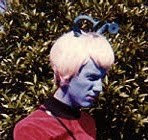Way back in 1881, my research discovered, the teachers at our school applied for funding to buy some innovative teaching machines, including an "Aphengescope". (I discovered that this obscure, patented term from 1843 refers to a device that was, essentially, a 'pair of lanterns' for projecting small opaque objects.) The headmaster of the day hoped such a machine would make science lessons "more interesting". His funding application was unsuccessful.
Some time early in the 20th century, the school was able to purchase a Ross epidiascope (epi-dia-scope) instead, which served a similar purpose. A forerunner of today's overhead projector, this bulky machine enabled still pictures to be enlarged and projected onto a wall. There are probably not many of these devices still in existence.
The epidiascope gets its name from combining EPIscope, a device for projecting opaque objects, and DIAscope, which projects transparent images in the same way as a slide projector. A knob moves an internal pointer for directing an audience's attention to parts of the projected image.
The two lens mountings represent the two methods of projecting still pictures. The lower has a standard glass slide carrier, fitted to the rear, which would be operated in the normal way. The upper lens mount was for projecting photographs, newspaper cuttings, other printed matter, and even small, flattish 3D objects, such as coins, plant specimens, or a working pocket watch. This was accomplished by the use of the separate projection platform below the body, on which objects could be placed, then raised mechanically until it made contact with a glass plate under the body.
Lit by the epidiascope's powerful lamp, and through various prisms, the image was projected by the upper lens. The lower lens is a F1.3 500mm and the upper lens is F1.3 250mm.
The other discovery was an unexpected showbiz connection. Old school magazines from 1974 mentioned an event whereby Australian actor Grigor Taylor, then of "Silent Number" and "Matlock Police" fame, had visited the school to pin prefects' badges on elected students - because he'd been School Captain himself at our school way back in 195x. (Digit deleted in case Mr Taylor hides his age.) The old honour board is located not far from my classroom and I've scanned it many times, but never noticed Grigor's gilded name emblazoned on it, until now.
One of our other teachers who, as a student, attended the same local high school as Grigor Taylor, recalled her excitement that Taylor's hand-scrawled name had appeared in one of her school text books, although he'd long been graduated. "He was quite a hunk in the 70s," she recalled.
I almost sorta met Grigor Taylor when he was playing school teacher Greg Walker in the school-based TV drama "Glenview High", opposite Elaine Lee and Rebecca Gilling, both of "Number 96" fame. I was at Channel Seven's Epping studios one day in 1978, feeling totally starstuck, to interview Elaine for a teachers' college media assignment, and the rugged Mr Taylor sauntered past with a wink and a smile. How many degrees of Kevin Bacon is that?

The day I almost got introduced to Grigor: young, impressionable, trainee teacher Ian McLean
(right, wearing Giovanni's deli jacket from "Number 96"), interviews Elaine Lee,
who was playing Principal Margaret Gibson in TV's "Glenview High" at the time.
A far cry from Vera Collins, eh?










No comments:
Post a Comment